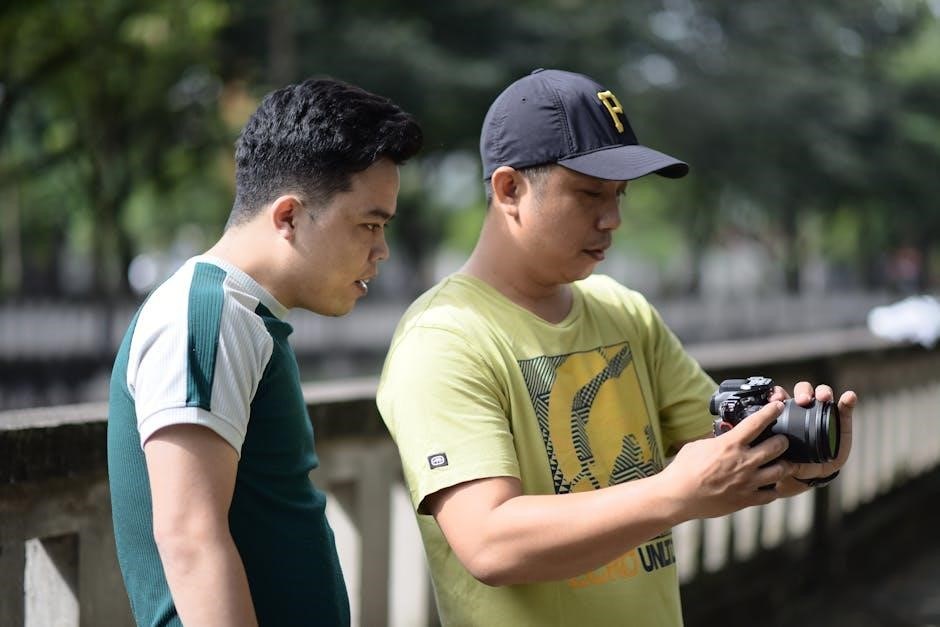Understanding the Basics of Guided Practice Activities 4A-4
Guided practice activities 4A-4 are structured exercises designed to help learners master key Spanish Language skills. These activities focus on verb conjugation and sentence structure, key elements for effective communication. The exercises often involve using irregular verbs like ‘ir’ and constructing meaningful questions in Spanish. Regular practice ensures learners develop fluency and confidence in their language abilities. These structured tasks help learners improve accuracy and retention of Spanish grammar. The activities also emphasize the importance of asking questions correctly and understanding verb forms, which are vital for advanced language use. Through consistent practice, learners can overcome common mistakes and build a strong foundation in the language. The exercises are designed to promote engaged learning and provide immediate feedback, ensuring students progress effectively. By completing these guided practice activities, learners can enhance their ability to communicate confidently in Spanish, making it an essential component of their language learning journey.
What Are Guided Practice Activities?
Guided practice activities are structured exercises designed to help learners develop and reinforce specific skills under teacher guidance. These activities often involve collaborative work with peers, allowing for immediate feedback and clarification. Guided Practice Activities 4A-4 specifically focus on Spanish language skills such as verb conjugation, question formation, and sentence structure. They provide learners with targeted practice to master key concepts, ensuring a strong foundation for advanced learning. By completing these activities, students can identify and correct common mistakes while deepening their understanding of Spanish grammar and usage.
The Importance of Spanish Practice
Guided practice activities, such as 4A-4, are essential for enhancing fluency and confidence in Spanish. By focusing on irregular verbs like “ir” and question formation, these activities aid in mastering key language components. Consistent practice not only reinforces grammar and vocabulary but also facilitates immediate feedback and correction, enhancing learning efficiency. These exercises provide a strong foundation, preparing learners for advanced topics and improving retention. By bridging theoretical knowledge with practical application, guided practice ensures effective and enjoyable language acquisition.
Key Features of Activity 4A-4
Activity 4A-4 focuses on building confidence in using irregular verbs and constructing Spanish sentences. It emphasizes the correct use of verbs like “ir” in various contexts, helping learners master verb conjugation. Through practical exercises, students practice forming questions and improving grammar skills, preparing them for advanced topics. The activity’s structured approach encourages learners to apply theoretical knowledge in real scenarios, ensuring better retention and understanding. By categorizing and practicing verb forms, learners can refine their language skills and enhance fluency in Spanish communication.

Guided Practice Workbook: Answers and Solutions
Comprehensive answers and solutions for Activity 4A-4 are provided, guiding learners to perfect verb forms and enhance communication skills in Spanish with practical exercises.
Answers to Activity 4A-4
The answers to Activity 4A-4 focus on verb conjugation and sentence structure. For example, questions like “¿Adónde vas?” require responses using forms of “ir,” such as “Voy a la escuela.” Answers often involve irregular verb forms and interrogative sentences. Carefully review your work to assess accuracy and identify areas for improvement, ensuring a deeper understanding of Spanish syntax and grammar.
Common Mistakes and How to Avoid Them
Common mistakes in Activity 4A-4 often involve verb conjugation, especially with irregular verbs like “ir.” For example, students may confuse “vas” (you go) with “vais” (you all go). Additionally, mixing up question structures and irregular forms can lead to errors. To avoid these mistakes, pay close attention to verb endings and subject-verb agreement. Practice regularly to reinforce correct forms and structures. Remember to double-check your work, as repeated errors can hinder progress. By focusing on accuracy and seeking feedback, you can refine your skills and master Spanish grammar effectively.

Mastering the Perfect Tense
Mastering the perfect tense is essential for effectively communicating past actions in Spanish. In Activity 4A-4, learners focus on irregular verbs such as “ir,” “ser,” and “ver.” The perfect tense combines the auxiliary verb “haber” with the past participle of the main verb. For example, “Yo he comido” means “I have eaten.”
Irregular verbs have unique past participles: “ido,” “sido,” and “visto.” Memorizing these forms is crucial. Additionally, the activity emphasizes using “ir a” constructions, like “Voy a la oficina” (I’m going to the office).
Forming questions in the perfect tense requires subject-auxiliary inversion, such as “¿Ha ido tú a la oficina?” (Have you gone to the office?). Common mistakes include misusing auxiliary verbs, using regular past participles with irregular verbs, and incorrect question formation.
To master the perfect tense, consistent practice and attention to verb conjugation rules and sentence structure are necessary. With dedication, learners can enhance their proficiency in using the perfect tense.

Strategies for Effective Learning
To master guided practice activities, break down tasks into smaller steps. Consistently review verb conjugations like “ir” to avoid errors. Use practice workbooks to reinforce skills like forming questions in Spanish. Regularly check answers to identify mistakes and improve retention. Effective practice requires focus and repetition to build fluency.
How to Use the Practice Workbook Effectively
To maximize the benefits of guided practice activities, approach the workbook methodically. Start by thoroughly understanding the instructions for each task, such as constructing questions or conjugating verbs like “ir.” Practice consistently to reinforce memory and accuracy. For challenging sections, break down the exercises into smaller steps and revisit them frequently. Regularly review your answers and address any mistakes to avoid repeating errors. Experiment with different learning techniques, such as incorporating vocabulary into sentences or using flashcards to memorize verb forms. Tracking your progress and celebrating small achievements will boost motivation and confidence in mastering the content.
Asking Questions in Spanish

Activity 4A-4 focuses on mastering the art of asking questions in Spanish. This involves using interrogative words like quién, qué, cómo, and Mastering verb conjugation is essential for effective communication in Spanish. Start with regular verbs, which follow predictable patterns, before tackling irregular verbs like ir (to go) or ser, which have unique forms in the imperfect tense, such as iba and veía. Pay attention to verb endings that change based on the subject and tense. Use examples from your practice workbook, such as Voy al parque (I am going to the park), to reinforce correct structures. Practice constructing sentences with interrogative words, like ¿Adónde vas? (Where are you going?), to improve fluency and accuracy. Avoid common mistakes, such as mixing up the preterite and imperfect tenses, by understanding their distinctions. Consistent practice and review will help solidify your verb conjugation skills, enabling you to communicate confidently and effectively in Spanish. Interactive activities engage learners by making practice dynamic and fun. Role-playing scenarios encourage learners to use irregular verbs like ir and construct questions in Spanish. Interactive exercises reinforce sentence structure while fostering confidence in real-life communication, creating an immersive and effective experience. Interactive practice is crucial for mastering Spanish through active engagement. By participating in activities like role-playing and constructing questions, learners apply grammar rules, especially verbs like ir, in dynamic, real-life scenarios. This method enhances retention, fluency, and accuracy, fostering confidence in communication. Interactive practice ensures learners develop practical language skills that prepare them for authentic interactions, making it an integral part of effective language acquisition. It provides a supportive environment for experimentation and mistake correction. Mastery of irregular verbs like ir is essential for effective communication in Spanish; These verbs, which do not follow regular conjugation patterns, are fundamental to constructing accurate sentences and expressions. Practice activities often include exercises focused on verbs such as ir, helping learners understand their unique conjugations and uses in various tenses and contexts. Understanding these verbs builds a strong foundation for language proficiency, enabling students to express themselves with confidence and clarity. Furthermore, interactive practice with irregular verbs enhances retention by allowing learners to apply these verbs in realistic scenarios, reinforcing their proper usage through repetition and engagement. This focus on irregular verbs ensures learners can navigate common daily conversations smoothly, elevating their fluency and comprehension. Sentence structure in Spanish often differs from English, particularly in question formation and verb placement. Unlike English, Spanish typically places the verb after the subject in questions, starting with an interrogative word. For example, “¿Quién va a la oficina?” contrasts with English’s “Who is going to the office?” Understanding such patterns is crucial for constructing accurate sentences. Spanish sentences also emphasize the use of verb phrases like “ir a” (to go), as seen in “Voy a la oficina” (I’m going to the office). This construction illustrates how verbs and prepositions work together to convey action and purpose. Mastering Spanish sentence structure involves grasping subject-verb agreement and article usage, which are integral to forming coherent sentences. Through guided practice activities, learners can reinforce these structures by applying them repeatedly in various contexts, enhancing their ability to communicate effectively in Spanish. Leverage guided practice by incorporating real-life scenarios and peer teaching. Focus on nuanced verb conjugations and spontaneous question formation to enhance fluency and confidence in advanced Spanish learners. Mastering irregular forms of “ir” is crucial for Spanish learners. The verb “ir” means “to go” and is highly irregular, with unique conjugations across subjects. For “yo,” it is “voy”; “tú” is “vas”; “él/ella/usted” is “va”; “nosotros” is “vamos”; “vosotros” is “vais”; and “ellos/ellas/ustedes” is “van.” These forms reflect actions happening now or in the near future. Conjugating “ir” correctly avoids confusion with other verbs. For example, in Voy al parque, “voy” means “I am going to the park.” Mastery of these forms enhances communication accuracy. Practice through exercises focusing on irregular conjugations. Activities like writing sentences or role-playing scenarios help reinforce correct usage, ensuring learners confidently navigate these unique forms. Consistent practice is key to achieving fluency in Spanish. Practice workbook activities are essential tools for reinforcing key language skills. They provide structured exercises that allow learners to apply grammatical rules and verb conjugations in practical scenarios. By focusing on irregular verbs like “ir,” “ser,” and “ver,” these activities enhance understanding and retention of complex language structures. The repetitive nature of workbook exercises aids in mastering correct verb forms and sentence structures. Additionally, access to answer keys enables learners to self-correct and refine their skills. Regular engagement with these activities boosts fluency and confidence, preparing learners for real-world communication in Spanish. Through targeted practice, learners can improve accuracy in verb usage and question formation, leading to more proficient language use. Guided Practice Activities are designed to enhance your understanding of Spanish grammar through structured exercises. These activities, particularly 4A-4, focus on essential grammar rules like verb conjugation, question formation, and the use of irregular verbs such as “ir,” “ser,” and “ver.” By engaging in these exercises, you reinforce foundational grammar concepts and improve your accuracy in constructing sentences. The repetitive nature of the activities aids memorization, while access to answer keys allows you to self-correct and refine your skills, leading to more confident and proficient language use. Consistent practice not only hones your ability to apply grammar rules correctly but also prepares you for more advanced aspects of the language. Through persistent effort, you will achieve mastery of Spanish grammar, enhancing your overall communication skills. Guided practice activities 4A-4 are essential for improving Spanish verb conjugation and communication skills. They focus on mastering regular and irregular verbs, such as ir, and constructing questions in Spanish. The activities emphasize the importance of accuracy and repetition in language learning. By completing these exercises, learners develop confidence in using the perfect tense and avoid common mistakes. Regular practice enhances fluency and helps learners achieve a higher level of proficiency in the language. To excel in Guided Practice Activities 4A-4, focus on consistent practice and active engagement with Spanish verb conjugation and sentence structure. Regularly review and apply irregular verbs like ir to build fluency. Use the workbook exercises to refine your ability to construct questions and responses accurately. Collaborate with peers or language partners to practice real-life scenarios and receive feedback. Additionally, explore supplementary resources like flashcards or online platforms for extra practice. Always review mistakes to understand and avoid repeating errors; Finally, immerse yourself in Spanish through music, movies, and readings to reinforce learning. Remember, persistence and active participation are key to mastering Spanish and improving your language skills effectively. Language learning is a transformative and rewarding journey that evolves through persistence and exploration. Guided Practice Activities 4A-4 serve as tools to help learners build confidence and fluency by engaging with essential skills like verb conjugation and constructing questions in Spanish. These activities contribute to a deeper understanding and command of the language, making communication smoother. The journey involves overcoming challenges, such as mastering irregular verbs like ir, and embracing the cultural contexts that enrich language use. By consistently practicing and seeking feedback, learners can refine their skills and progress toward becoming proficient in Spanish. Each step taken in this journey is a celebration of growth and the pursuit of effective communication.Verb Conjugation Tips

Interactive Activities for Spanish Learners

Role of Interactive Practice
Using Irregular Verbs
Sentence Structure in Spanish

Advanced Techniques for Guided Practice
Mastering Irregular Forms of Ir
Practice Workbook Activities and Their Benefits


Perfecting Spanish Grammar Rules
Guided practice activities 4a-4 answers offer essential insights into mastering Spanish grammar and verb conjugation. Consistent practice reinforces foundational skills, improves sentence structure, and enhances communication proficiency. Embracing these exercises and learning from mistakes are vital steps toward achieving fluency and confidence in Spanish. Keep practicing and expanding your language abilities with dedication and enthusiasm.Tips for Continued Improvement
The Journey of Language Learning
